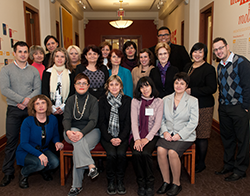Bulgaria Was In the House
As her brief, busy stay in New York City was winding down, Nellie Gospodinova was buzzing with ideas to transform the way she teaches high-school English in Silistra, a small city on the Danube River in northern Bulgaria.
“I can change the physical set-up of my classroom,” said Gospodinova, who teaches at a large vocational school where students prepare for careers in accounting, banking, and other business fields. “I can make my class more student-centered and introduce more authentic performance tasks so students can feel more engaged.”
That’s just one strategy Gospodinova learned during the non-stop program of classroom and field activities that she and 14 other teachers experienced in October as part of this year’s Bulgarian Young Leaders Program at Teachers College.
The three-week program is run by the America for Bulgaria Foundation and the Institute of International Education and hosted by both TC’s Office of International Affairs and the College’s Center for Technology and School Change (CTSC). The Bulgarians spent three days each week with CTSC’s co-director, Ellen Meier, and her team of professional development specialists, absorbing an intense program on curriculum and project design, assessment and leadership. Caron Mineo and Kenny Graves from CTSC coordinated the daily sessions at the college. On other days, the teachers from Bulgaria fanned out to a half-dozen public and independent schools around the city to watch different methods in action.
The program reflects CTSC’s emphasis on the use of technology not in isolation, but as part of an overall rethinking of the learning experience.
“It’s about using technology as a catalyst for teaching and learning in new ways,” Meier said. “It’s how we can go about the business of learning in more dynamic ways, and that takes both technology and design work in terms of rethinking the learning environment.”
The participants spent several sessions discussing the differences between school systems, curricula and policy environments for school change in the United States and Bulgaria, and what teachers in each country might learn from one another
Meier said both countries face a common challenge as more technological tools become available for use in education.
“Teachers need help in learning how to design thoughtful classroom projects with these tools,” Meier said. “Otherwise we risk appropriating the tools in ways that simply reinforce the status quo, as opposed to using them to explore new ways of creating learning opportunities for all students.”
The Bulgarian participants were quite tech-savvy to begin with. “We have multimedia, smart-boards, and I’m a big Moodle fan,” said Ludmila Teneva, who teaches English in Smolyan, a ski-resort town. “But we saw a lot of different uses of technology, and this will bring more variety into my teaching process.” The program's emphasis on the design process helped teachers develop new approaches and projects organized around student understandings.
“The most striking thing is: I’ve been doing things the wrong way!” said Kremena Radoeva, who teaches at a different school in Silistra. “Now I see should have started designing my syllabus and my classroom projects starting from the goals, not from the activities, and working backwards toward the different ways to achieve them.”
Bulgaria’s population, at 7.3 million, is smaller than New York City’s. Gospodinova said that simply being immersed in the city’s life and diversity was both overwhelming and stimulating. Visiting schools and watching teachers at work here, she said, showed “the American education system in action. It’s different from what books or what people might say, because you see how people function.”
As the program ended, Meier reminded participants that they might have to pick and choose among all the new ideas they would want to share with their colleagues back home. She invited them to work with their colleagues collaboratively, in the same spirit of “co-creation” that she tried to bring to the training program.“I can be more efficient in my classes now,” Gospodinova said. “And I can be more inspiring for my students. That’s the moral reward when you’re a teacher.”
Published Monday, Nov. 18, 2013
